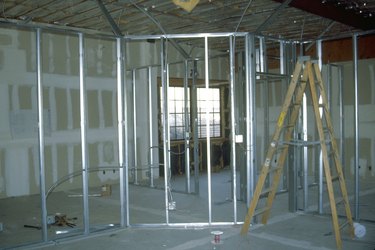
Although generally more expensive than wood studs, metal studs exhibit several structural and quality advantages over conventional wooden framing. Whereas wood framing naturally expands and contracts and occasionally warps, steel framing remains stable and consistent under normal conditions. Also, metal studs are lightweight, easy to work with and strong; they are suitable for 24-inch on-center stud walls, compared to wood's typical 16 on-center. Manufacturers press and roll steel into C-shaped studs that resemble the standard wood stud sizes, such as 2 x 4 inch and 2 x 6 inch and offer metal framing products in individual pieces or preassembled units.
Common Metal Stud Sizes
Video of the Day
Home improvement stores regularly stock a selection of common metal studs. The metal stud equivalents of wooden 2 x 4-inch lumber and 2 x 6-inch lumber are nearly always available. Slight differences exist between the dimensions of lumber and metal studs. For example, a lumber 2 x 4-inch plank measures roughly 1 1/2 x 3 1/2 inches and a metal 2 x 4 measures 1 5/8 x 3 1/2 inches; a lumber 2 x 6-inch plank measures 1 1/2 x 5 1/2 inches and a metal 2 x 6 measures 1 5/8 x 6 inches.
Video of the Day
Conventional Framing With Steel Studs
Conventional, stick framing with steel studs resembles stick framing with lumber. In wood framing, vertical support members called studs run between horizontal framing members called plates; vertical support members called studs run between horizontal framing members called tracks in metal stick framing. Both metal studs and metal tracks consist of two components: flanges and web. The term flange refers to the edge of the stud or track, equivalent to the 1 1/2-inch edge of lumber framing material. The term web refers to the width of the metal stud or track, equivalent to the face of lumber framing material. With two flanges and a single web, metal studs and tracks have a C-shaped profile.
Metal Stud Framing Components
In addition to stud and track, metal stud framing systems include several specialized components, namely U-track, furring material and headers. Framers typically apply U-track and furring material for finish applications, such as cabinetry support, blocking and bridging spaces between metal studs. The term header refers to a large support member placed above openings in a structure's walls, such as windows and doors. In wood framing, headers are typically beams or timbers, such as 4 x 6-inch lumber. In metal framing, headers are L-shaped pieces of sheet metal.
Panel Systems
Many steel framing manufacturers offer preassembled panel systems. Metal framing panel systems are assembled in a factory and shipped to retailers or directly to work sites. Unlike wood, which might sustain damage or warp during shipping and assembly, metal panel systems remain stable and intact. Even assembled into wall units, metal framing is relatively lightweight.